


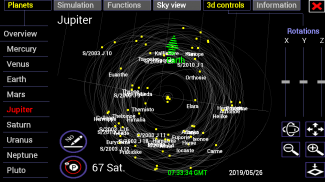
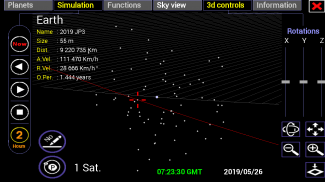
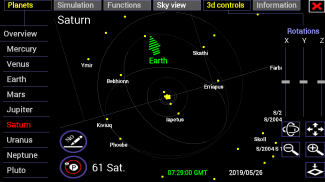
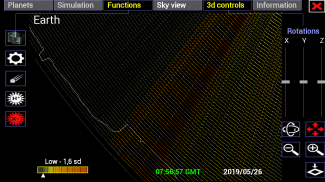

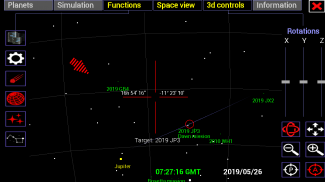
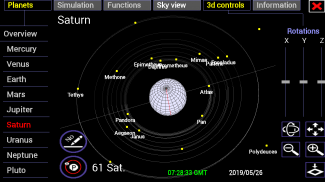
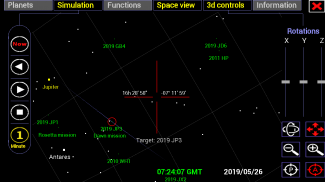
Asteroid Alert

Descrição do Asteroid Alert
This is a scientific application that simulates the solar system dynamics using the information provided by the NASA NEO Program. The Near Earth objects and objects close to other planets will be reported in real time. The advanced graphical interface allows you to monitor the orbits of celestial bodies as a function of the elapsed time.
X rays and protons emitted by Sun are also notified to have a complete view of the dangers from space.
FEATURES
● User friendly graphical interface
● Sky view mode
● Sensor targeting
● Spherical coordinates of selected objects
● 2 Notification levels basing on severity or proximity to the Earth
● Notification of objects close to other planets
● Notification of solar wind events (X rays and protons)
● News regarding asteroids and scientific projects
● Detailed information of NEO (Size, Velocity, Distance, orbital period)
● Target links to space missions
● NEOs database updated every day
FOR PRACTICAL REASONS
● The maximum resolution is achieved for asteroids that are less than 0.1 AU from the planets. The application photographs the situation on the current date and simulates events that will occur in the future or have occurred in the past.
● The number of asteroids plotted in the asteroid belt is only a fraction of the real number.
● The asteroids not yet included in the NASA NEO database may not be notified.
● X rays and protons levels are processed and saved continuously. The solar activity indicated as a significant event, has been inferred through the Statistical analysis of about 6 months of data sampling. The prediction will be improved with the increasing of data amount.
NOTIFICATION CRITERIA:
● With the exception of the first notification, new notifications will be generated only if NEOs are approaching. The distance of the NEO to the planet must be at least 10% lower than that reported in the previous notification.
● NEO notifications have priority over solar notifications except for powerful events.
Space is our next frontier.
Esta é uma aplicação científica que simula a dinâmica do sistema solar usando as informações fornecidas pelo Programa NEO da NASA. Os objetos próximos da Terra e objetos próximos a outros planetas serão relatados em tempo real. A interface gráfica avançada permite monitorar as órbitas dos corpos celestes como uma função do tempo decorrido.
Raios X e prótons emitidos pela Sun também são notificados para ter uma visão completa dos perigos do espaço.
RECURSOS
● Interface gráfica amigável
● modo de visualização do céu
● segmentação por sensor
● Coordenadas esféricas de objetos selecionados
● 2 níveis de notificação com base na gravidade ou proximidade com a Terra
● Notificação de objetos próximos a outros planetas
● Notificação de eventos de vento solar (raios X e prótons)
● Notícias sobre asteróides e projetos científicos
● Informação detalhada do NEO (tamanho, velocidade, distância, período orbital)
● Links de destino para missões espaciais
● Base de dados da NEO atualizada todos os dias
PARA MOTIVOS PRÁTICOS
● A resolução máxima é alcançada para asteróides com menos de 0,1 UA dos planetas. O aplicativo fotografa a situação na data atual e simula eventos que ocorrerão no futuro ou ocorreram no passado.
● O número de asteróides plotados no cinturão de asteróides é apenas uma fração do número real.
● Os asteróides ainda não incluídos no banco de dados da NASA NEO podem não ser notificados.
● Os níveis de raios X e prótons são processados e salvos continuamente. A atividade solar indicada como um evento significativo, foi inferida através da análise estatística de cerca de 6 meses de amostragem de dados. A previsão será melhorada com o aumento da quantidade de dados.
CRITÉRIOS DE NOTIFICAÇÃO:
● Com exceção da primeira notificação, novas notificações serão geradas somente se os NEOs estiverem se aproximando. A distância do NEO ao planeta deve ser pelo menos 10% menor do que a relatada na notificação anterior.
● As notificações do NEO têm prioridade sobre as notificações solares, exceto em eventos poderosos.
O espaço é a nossa próxima fronteira.




























